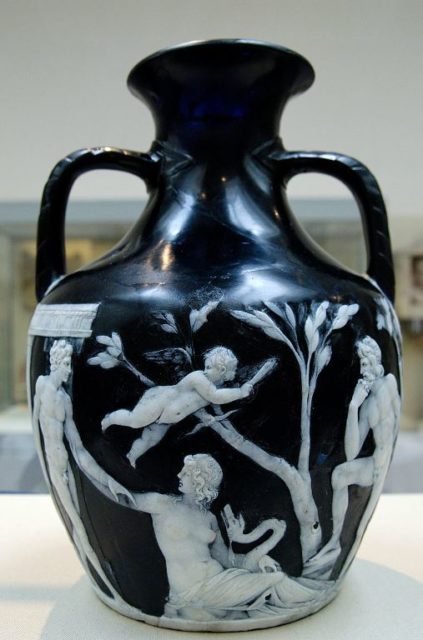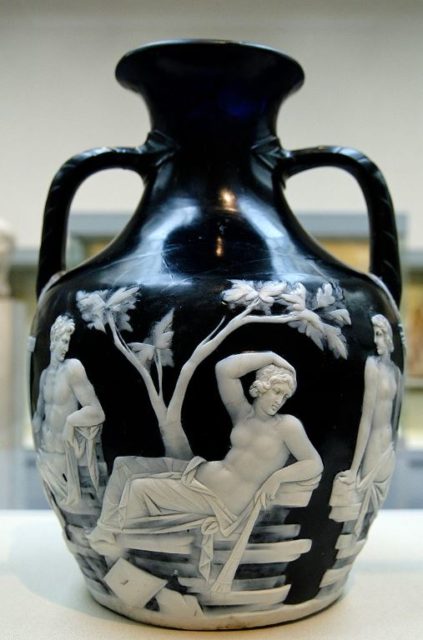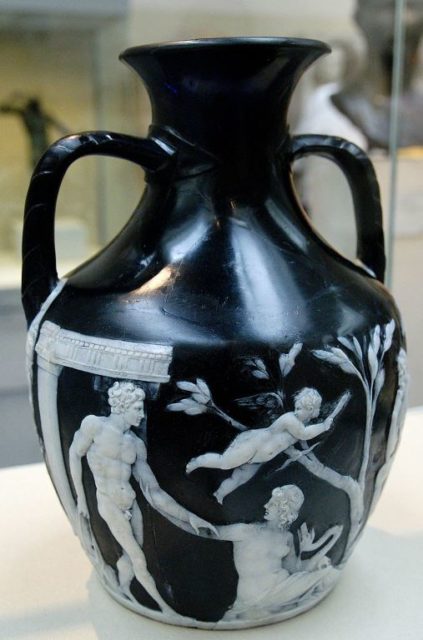In every corner of the world, people can take pride in their ancestors’ heritage, left behind as legions of antiquities and artifacts. Some, after years of analysis, still have secrets to tell. These artifacts might never entirely reveal their origin, purpose, or source of inspiration, and much of their identity relies on assumptions and theories. One such item is the fragile Portland Vase in the British Museum–a rare 1st century B.C. Roman cameo glass vessel.
This two-handled amphora was found in the sarcophagus of the tomb of Emperor Alexander Severus, near Rome, at the beginning of the 17th century. Since its discovery, it has intrigued glass and porcelain makers as well as art historians who tried to understand the mysterious scenes depicted on its surface. The vase was made of two layers of glass–an opaque white overlayer and a dark blue, almost cobalt, underlayer. The white layer is cut away so that the figures stand out in relief against the dark, cobalt layer.
Over time, scholars, thinkers, artists, and philosophers have come up with dozens of interpretations to explain the imagery on the vase.

Among the figures, the identity of only one of them is agreed upon, that of Cupid. This figure holds a bow and a torch, fluttering in the air, as though to lure a young man towards a semi-naked woman who embraces a slithery monster, presumably a sea serpent.
As for the remaining characters in the two scenes, there is disagreement over whether they represent real historic or mythological scenes. Theories include that of one scene depicting Mark Antony being lured into disrepute by the Egyptian queen Cleopatra, which is alternatively interpreted as the marriage of sea gods Peleus and Thetis. The second scene might represent Mark Antony’s wife, Octavia Minor, abandoned in Rome. Others relate the design to a story from Greek mythology, of Hecuba’s prophetic dream about the fall of Troy.
According to Graham Fisher, a trustee of the British Glass Foundation, who delved into the fascinating history of the Portland Vase, it did not capture general interest until it was broken in 1845.

One February mid-afternoon in that year, a 19-year-old man entered the British Museum and went straight to the room where the Portland Vase was displayed. The visitor, whom it was later revealed had been drinking, took up a nearby sculpture and proceeded to deliberately smash the vase with it. Museum guards were quickly on the scene, and the young man was taken to Bow Street Police Station, where he gave a false identity.
At the museum, the curators gathered the 189 pieces, and these were taken to the basement. In seven months, the vase was restored by one skillful employee and her assistant. The perfect job of reconstruction brought the vase back, placed in its glass case again, so visitors kept on admiring it. However, with time, the transparent glue yellowed and became visible.
The museum officials decided to reconstruct it again in 1989–but first, it had to be “broken” again. A team of experts immersed the vase in a desiccating solvent to soften the old adhesive, then peeled off and washed each of the vase fragments. With a new, natural adhesive and resin, the pieces were reassembled and finished with ultraviolet light. The work took nine months and was constantly checked by an electron microscope. The result was quite optimal as it assured another hundred years of life for the vase.

Of course, the odd mishap of the Portland Vase vandalism was reported in the newspapers. Not only did the public became more aware of this piece of ancient cameo glass, but also the glass-making industry decided to capitalize on it by creating replicas. Cameo glass examples are considered an exceptional rarity, and this may be ascribed to the time-consuming production of this style. The first replica-maker of the Portland Vase, John Northwood, took three years to produce it. According to Fisher, there have been a total of five replicas made.
The 19th century re-creations set out for others a serious challenge of new criteria in the glass world. The subsequent re-creations also demonstrated to the wider world that the skills needed to create cameo glass were definitely not lost but are still very much in existence. In the words of Fisher, the quality of the work is absolutely par excellence, as he states:
“Looking back to the original manufacture 2,000 years ago, and those Romans who were working to produce this piece of glass that we don’t know what for or why, it would be interesting to speculate if they could, even in their wildest dreams, imagine that 2,000 years hence not only would that piece of cameo glass be revered still around the world by everyone but it would also represent a beacon of excellence in the world of cameo glass.”
